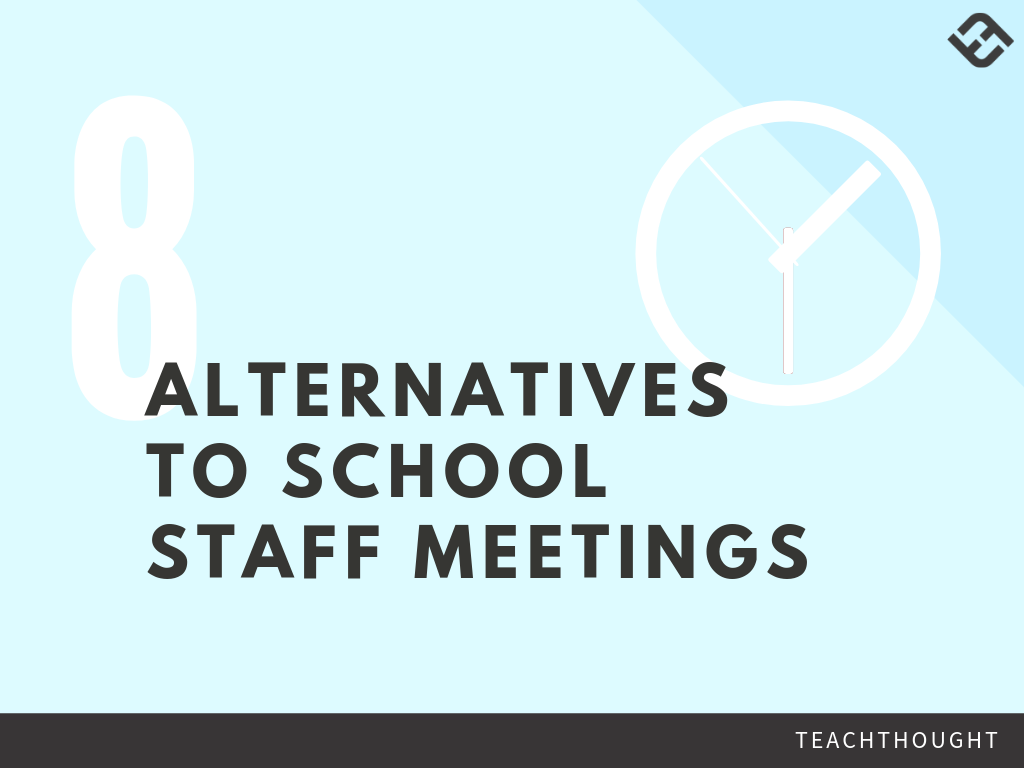
A List Of Better Alternatives To Teacher Staff Meetings
by TeachThought Staff
We were recently admin’ing the TeachThought twitter feed when we saw four tweets in six minutes regarding ‘tips’ for ‘paying closer attention’ in staff meetings. There is a lot implied in this kind of thinking, namely:
1. Schools have a lot of meetings
2. Educators (of all position) have trouble paying attention in said meetings
3. Teachers lack the professionalism to focus on what’s most important, or that the content in the meetings isn’t really that important
4. Improving “focus” for said unengaged educators is a matter of listing tips, rules, and ‘norms’
It’s unclear why we just accept that meetings are, in general, boring and inefficient and ‘that’s just the way it is’? We’ve talked about boring staff meetings before (seemingly a sore spot for us). So we asked our followers–perhaps rhetorically–what would make it better, and got a simple, but authentic response.
When we’ve brought this up before, we’ve gotten pushback with many teachers saying their meetings are useful and engaging. It could well be that we expect too much of them or just had bad luck. Nonetheless, a few tips on how we could improve school staff meetings–and in some places replace them altogether–appear below.
Note, one big idea may be to simply be smarter from the top-down by creating less wasteful and redundant district and state ‘policies’ that make said time wasting a matter of law. Make the product, effect, or big idea a matter of policy, not the paperwork and physical presence. We do the same with students. This is why attendance and behavior aren’t matters of school accountability, but assessment performance is.
8 Alternatives To School Staff Meetings
1. Empower small groups for quicker, more personalized and adaptive meetings.
Consider technology like Skype for small groups meetings based on who needs to know what–they don’t even have to be in the same room, or even on computers. Video conferencing–use the data team or lit circle format if you’d like. Live stream it if you must. Every teacher has a role. Notes get uploaded and tagged. Admins and group leaders get cc’d.
2. Use a project-management platforms.
Another alternative to school staff meetings is to use a project-management platform like Trello, Slack, or Redbooth on an ongoing basis.
Many of these have advanced assignment features, messaging, user tagging, and even video meeting. A clearly organized board makes sure everyone is literally on the same page and allows teachers to access the data anytime, from anywhere. Build in usability, accountability, communication, and task distribution however you’d like.
3. Workshop-style, ‘PD meetings’
This is a kind of hybrid approach to school staff meetings where information is distributed while teachers help other teachers learn important things that (ideally) help them become better teachers. It’s like taking the current model of teacher staff meetings and embedding some PD within.
4. Lean more heavily on direct communication technology (not email).
Use direct communication technology like Voxer. Think of it like voice text messaging, with sent receipts, offline use, image support, groups, and more. No, Voxer can’t replace a meeting as they exist today, but used well, it (and Trello and Slack) can greatly reduce the need to meet and change the nature of the face-to-fact interactions altogether.
5. Use email–but more efficiently!
Use bulletpoint mass emails with need-to-know info, and clear, specific call-to-actions for response.
6. Use Facebook Groups
Create a closed Facebook Group to communicate, share, document, and curate training, info exchange, etc. This would operate like a closed-circuit online group. If you’re concerned about data privacy and have tech-savvy teachers, it’s not at all difficult to create your own on a private server.
7. Use twitter
Use an ongoing, school or department-specific twitter hashtag to promote conversations where comments are aggregated and automatically embedded in a mass document for ‘accountability.’ Again, you won’t be able to discuss private information or share specific data on a public social media platform, but like Voxer, this is a technology that can reduce the frequency of the ‘normal meetings.’
If it’s done well and has buy-in from staff. If not, this one has the most potential to be a collosal waste of time.
8. Consider webinars
Need something more robust? Consider a platform like gotomeetings that allow for webinar-style digital interaction.
These platforms, while expensive, have a lot of built-in tools and features to potentially increase the effectiveness (which is different than efficiency) of your school staff meetings. And like all the rest, how functional it would be in this capacity depends entirely on the specific genius of your use and your ability to get staff ‘on board’ with the whole idea–which often boils down to the perceived utility of the meetings.
While none of these alternatives to school staff meetings can neatly replace existing meetings with exact function and form, before you dismiss this thinking (or your own better thinking) because teachers ‘won’t use it,’ ask yourself how closely teachers are using the meetings as you have them today.
